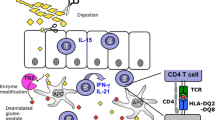Abstract
DQw2 (MB2) was originally defined in 1979 by a cluster of five Seventh Workshop B-cell antisera as a new HLA-D region antigen associated with DR3 and DR7 [1], This determinant is similar to Te24 [2] and DC3 [3]. During the Eighth Workshop, DQw2 could be defined by a serum cluster with high correlation values [4]. However, most sera in this cluster also contained DR7 antibodies, making DQw2 assignment on DR7 cells more difficult. Although DQw2 has been suggested to present a cross-reacting group of DR3 + DR7 antigens, recent biochemical data from different laboratories have demonstrated that DQw2 resides on class II molecules different from DR molecules and perhaps equivalent to the murine I-A molecules [5, 6]. This would suggest that DQw2 may be controlled by a distinct HLA-D gene. Disease association studies have shown strong associations of DQw2 with celiac disease and dermatitis herpetiformis.
Work supported by AI-21410
Access this chapter
Tax calculation will be finalised at checkout
Purchases are for personal use only
Similar content being viewed by others
References
Duquesnoy RJ, Marrari M, Annen K (1979) Identification of an HLA-DR associated system of B cell alloantigens. Transplant Proc 11: 1757
Park MS, Terasaki PI (1980) Second DR locus. In: Terasaki PI (ed) Histocompatibility testing 1980. UCLA Tissue Typing Laboratory, Los Angeles, pp 578–582
Tanigaki N, Tosi R (1982) The genetic control of human la alloantigens: a three-loci model derived from the immunochemical analysis of “supertypic” specificities. Immunol Rev 66: 5
Duquesnoy RJ, Marrari M (1980) MB system joint report. In: Terasaki PI (ed) Histocompatibility testing 1980. UCLA Tissue Typing Laboratory, Los Angeles, pp 552–555
Tanigaki N, Tosi R, Duquesnoy RJ, Ferrara GB (1983) Three IA species with different structures and alloantigenic determinants in an HLA-homozygous cell line. J Exp Med 157: 23
Shackelford A, Strominger JL (1984) Identification of three class II antigens, DR7, MB2, and MT3, from a homozygous human cell line. Hum Immunol 9: 159
Tongio M, Mayer S (1983) Which is the antigen recognized by serum 9W775? Ninth Workshop Newsletter 2
Dupont B, Braun DW, Yunis EJ, Carpenter CB (1980) HLA-D by cellular typing: joint report. In: Terasaki PI (ed) Histocompatibility testing 1980. UCLA Tissue Typing Laboratory, Los Angeles, pp 229–267
Nunez G, Stastny P (1983) Different MB specificities are associated with DRw9. Ninth Workshop Newsletter 5
Author information
Authors and Affiliations
Editor information
Editors and Affiliations
Rights and permissions
Copyright information
© 1984 Springer-Verlag Berlin Heidelberg
About this paper
Cite this paper
Marrari, M., Duquesnoy, R.J. (1984). Antigen Report: HLA-DQw2. In: Albert, E.D., et al. Histocompatibility Testing 1984. Springer, Berlin, Heidelberg. https://doi.org/10.1007/978-3-642-69770-8_89
Download citation
DOI: https://doi.org/10.1007/978-3-642-69770-8_89
Publisher Name: Springer, Berlin, Heidelberg
Print ISBN: 978-3-642-69772-2
Online ISBN: 978-3-642-69770-8
eBook Packages: Springer Book Archive




